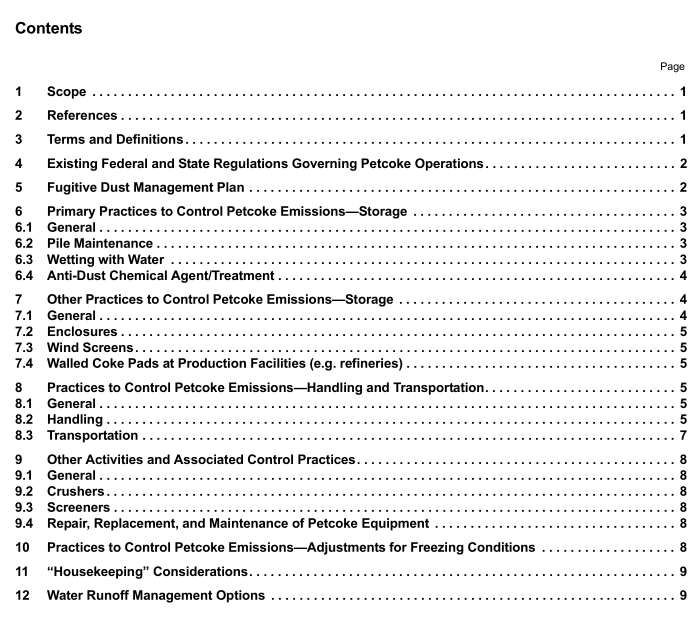API GD PC1-2014 pdf download

API GD PC1-2014 pdf download Guidance Document for the Storage and Handling of Petroleum Coke
6 Primary Practices to Control Petcoke Emissions-Storage6.1General
Petcoke storage may occur at a variety of locations including the point of production, an intermediate logisticsterminal, and the end user facility. At each of these locations, maintaining the optimum moisture content of petcoke isa key practice required to control petcoke fugitive emissions. There are three primary techniques that should beconsidered to maintain optimal moisture content and control potential petcoke emissions (i.e. fugitive dust) duringstorage:
1) pile maintenance,2) wetting with water, and
3 treating with an anti-dust chemical agent.6.2Pile Maintenance
Pile maintenance is important as a method to control potential fugitive dust. Proper maintenance of petcoke piles willhelp reduce the potential for fugitive dust emissions,particularly when combined with wetting or ant-dust chemicalagent practices, as discussed in 6.3 and 6.4. More specifically, the following should be considered with regard toproperly maintaining a petcoke pile:
-pile height consistent with facility’s water application capabilities,-shaping of the piles to remove peaks and sharp edges,
-pile compaction,
-reclaiming practices designed to reduce potential dust emissions,
– pile stacking practices designed to reduce potential dust emissions (e.g. minimizing drop height from stacking
conveyors).
6.3Wetting with Water
An emission control technique that is commonly used at petcoke storage locations is the application of water tostorage piles. The systematic application of water to petcoke helps to control fugitive dust emissions and maintainproduct moisture content, and can be accomplished through both portable and fixed infrastructure. Water increasesthe particle weight and acts as a binding agent between particles. Water spray systems may require periodicreapplication of water to overcome the hydrophobic nature of petroleum coke. Wetting systems for petcoke piles caninclude the following:
water cannons;
-water trucks;
misters and aerial sprays.
The following issues should be considered when using water spray systems on petcoke piles:- location of components (e.g. cannons, misters, sprays, etc.) relative to the location of the piles;
_frequency of water spray system operation;
-application rate;
adjustment of frequency or application rate depending on weather forecasts/conditions;
-adequacy to cover targeted area;
-freezing temperatures may require additional practices to mitigate fugitive dust (see Section 10)
An engineering analysis may be required to determine the correct wetting systems for the piles. Ultimately, the mosteffective water application technology for an operation will be dictated by site specific conditions, but the primaryconsiderations when selecting wetting equipment are:
-ensure the operation meets existing permit requirements;
-integrity of the product is preserved;
-optimal moisture content is achieved on a repeatable basis.6.4Anti-Dust Chemical Agent/Treatment
In some situations, water spray systems can be combined with anti-dust chemical agents such as surfactants andhumectants. Application of anti-dust chemical agents is normally achieved by combining the chemical into the waterspray.The surfactant enhances the wetting by lowering the surface tension of the water thereby allowing the waterdroplets to penetrate deeper into the petcoke.Humectant helps slow moisture evaporation.
The use of anti-dust chemical agents may offer the following benefits:
– have a residual effect of up to 45 days or more for pile integrity, depending on weather conditions and type of
chemical used;
-minimize need for reapplication of water;-allow additional coke pile height, if needed;
-routine cleanup requirements for the coke conveyors may be reduced;
-maintenance needs within the coke handling facilities may be reduced.
7 Other Practices to Control Petcoke Emissions—Storage 7.1 General In addition to the three primary practices to control petcoke fugitive dust from storage mentioned in Section 6, other practices that a site storing petcoke may consider include enclosures or wind screens. In addition, refineries that produce petcoke may consider walled petcoke pads. These additional practices are discussed further in 7.2, 7.3, and 7.4, and may be considered if management of product moisture content is not effective in meeting permitted fugitive dust emission requirements.









